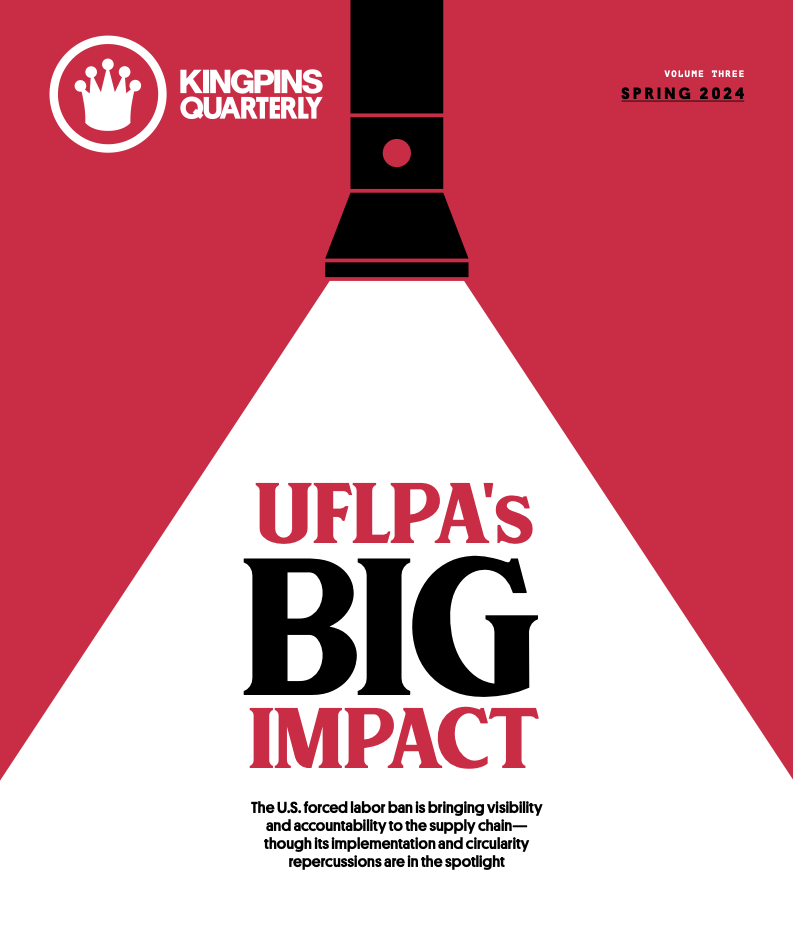Artificial intelligence allows computers and machines to mimic capabilities of the human mind when it comes to solving problems, making decisions and creating. In apparel, we’re currently in a Wild, Wild West where the learning curve is steep and the payoff is potentially rich. In the next three to five years, generative AI could add $150 billion to $275 billion to the apparel, fashion, and luxury sectors’ operating profits, according to McKinsey & Company. While much of the backbone relies on transforming marketing, merchandising, digital commerce and store operations, apparel design is also ripe for a metamorphosis.
According to McKinsey, there will be several ways to accelerate product development and design with AI. Most immediately is generating sketches and mood boards into high fidelity designs. For product ideation, possibilities lie in collaborating with AI agents to generate creative options (new ideas or style variations) from data (past product lines or inspiration). Customization is another big opportunity, namely, bringing individualized styles to scale.
AI is already transforming some aspects of denim design but an even bigger shift is on the horizon.
Addressing Fit
To date, fit has probably received the most attention as it relates to design. For instance, Blue Delta Jeans has been creating custom jeans in the U.S. since 2012. The Mississippi-based company started with in-person measurements but has since leveraged AI to make bespoke jeans a reality with just a few data points submitted online like shoe size, age, preferred jeans style and bra size (for women). As a result, return rates for the company have fallen to 7 percent.
With the success of AI in fit, Blue Delta Jeans chief design officer Johnson Benjamin envisions the technology also “being used in a conceptual phase of design to generate rough ideas that would need to be enhanced/finished by hand.” In the future, he said AI may be used to generate a base pattern. However, Benjamin expects that pattern would still need to be refined by a member of his team.
Beyond bespoke garments, Shilo Byrd, a patternmaker and owner of an L.A.-based product development agency, said AI is best suited for nailing fit during the product development process. In her experience, most companies don’t devote sufficient time to building out a library of tried-and-true bodies and blocks that can be used time and again. Additionally, bigger brands work with contractors who all have their own processes. The result is frustrated shoppers and inconsistent fit. “AI would be able to identify—through sales data—what styles are most successful from a fit perspective. Then, companies could know which bodies they want to continue working with and distribute those base patterns to their various contractors,” she said.
Getting Creative
Beyond fit, productivity would be a huge unlock when it comes to AI in fashion, according to Byrd. For instance, merchandising and trend forecasting teams currently rack up hundreds of man hours on data analysis. “Instead of somebody inputting all the data on what sleeve length or pant width is trending or selling based on sales data or market research, AI could do a lot of that really, really quickly,” she said.
From a design perspective, AI could slash research hours as well. AI could synthesize inspiration culled from red carpets, street style, social media and vintage collections to determine what people are reacting to in a fraction of the time it would take humans, according to Byrd. With those trends identified, the team could further lean into AI to generate initial design ideas, a process that’s now done manually by junior designers. “I think it’s a good thing that will open up more time for designers to really build up the storytelling and the real creative work,” Byrd said.
Dejan Zvekic, Material Exchange’s chief of digitalization, has been digging into AI’s capabilities and has found it to be a powerful design tool, especially when the designs are based off of data-rich 3D renderings. “If you have a 3D model of the material, there are six layers of information: one, how the light is diffused; another one how it reflects the light; one showing any kind of roughness to the texture. So, when you have the six layers, AI understands the material and can actually find something similar that it can then use to generate a design,” he said.
From there, iterating on designs is fast because AI reduces the reliance on physical samples, Zvekic said. For instance, for a designer who wants to update a best seller, they would feed the current design into the software along with prompts related to the colors, patterns or textiles to use. The result would be iterations on the initial design from which the team can then select the best options to tweak, as necessary. Ultimately, the biggest benefit would be the truncated timeline.
“Everything could be decided in almost a real-time meeting, instead of a couple of days or maybe weeks [between versions for review]. You could accomplish the same in a three-hour session with a good technician giving the right instructions,” he said, also acknowledging the cost savings associated with minimizing IRL samples.
Material Exchange is leveraging these AI tools to help companies visualize their textiles better. The company currently offers a marketplace of curated materials spanning a variety of suppliers, complete with product descriptions and photos—everything a buyer would need to make a product selection. By the end of the year, Material Exchange plans to augment how these materials are presented, bringing them to life through a variety of AI-generated designs on photorealistic bodies that demonstrate how the textiles look on the body in real-life scenarios.
“[Buyers will] be able to see them simulated in 3D in different washes and colors with the features and the details and even get ideation from live examples of what designs might be like, which they can then take forward into their own design journey and process,” said Ben Felton, chief strategy officer of Material Exchange.
Looking to the Future
Vertically-integrated denim manufacturer Soorty is already creating AI-generated designs of its own. The company’s HumAIn collections explore the possibilities that AI will enable in manufacturing, creativity, on-demand customized design and digital capabilities. For its second collection, HumAIn Chapter 2, Soorty worked with menswear designer Volker Ketteniss with Denim Dudes, providing Fall/Winter 2024/25 trend direction to create modern takes on denim.
While AI provides a base, Ebru Debbag, executive director, global sales and marketing at Soorty said, “the design process is progressive—you still have to work with building blocks and attend to details in design and manufacturing.”
It’s this human interaction that prompted FIT adjunct professor Mikelle Pellum to soothe fears that AI could take over fashion design jobs. It’s “not likely and definitely not anytime soon,” she said. During a review of the MidJourney AI software, Pellum, who’s also a corporate digital design software trainer, said these types of programs are a tool and not a replacement. “Although AI can generate lots of current interpretations of a design, it’s based on data and an algorithm. It can’t replicate the unique perspective and personal attention from a designer,” she said. “And if you’re creating fashion for physical garments, there are a lot of other skills like garment construction, materials selection, sourcing, production management, that require the expertise and experience of a human.”
Byrd said those capabilities plus a willingness to lean into technology will be necessary going forward. “I do think those core skills are still going to be necessary but they’ll just be utilized in different ways,” she said. “AI can take over a certain portion of my workload, but I’ll still have a full workload. I’m not worried about my job completely going away. Maybe my job would turn into a slightly different version of my job.”
—additional reporting by Caletha Crawford




